The Most Beautiful Villages
View Contents
ToggleAs we have said before, this website is made by people from Tenerife, so what we are going to talk about here is a general feeling in the population of Tenerife.
The fact is that the most beautiful villages of Tenerife are in the north of the island, they tend to be villages with more charm, they are better preserved, their landscape is less arid, this means that if you compare the north of the island with the south, the north tends to win in beauty.
Garachico
Garachico is one of the historical gems of Tenerife, located on the northwest coast of the island. With a rich history marked by volcanic eruptions, tsunamis, and fires, Garachico offers a testament to resilience and cultural preservation. This charming coastal town, once the main port of Tenerife, now invites visitors to explore its architectural heritage, traditions, and unique natural surroundings.
A little history
Founded in the 16th century, Garachico quickly thrived due to its natural harbor, which became an important trading point between Europe and the New World. However, in 1706, the eruption of the Trevejo Volcano drastically changed the fate of the town by burying much of the harbor and several buildings under lava. Despite this devastation, Garachico rose from its ashes and transformed its tragedy into a rich cultural heritage that can still be appreciated today.

Landmarks
- El Castillo de San Miguel: This 16th-century castle, now a museum, served as a fortress against pirate attacks. Located by the sea, it offers insights into Garachico’s military past and an impressive view of the Atlantic Ocean.
- El Caletón Natural Pools: Formed by the volcanic lava that flowed into the sea during the 1706 eruption, these pools are one of Garachico’s major tourist attractions. They provide a safe and unique place to swim and enjoy the sea, perfectly integrating the marks of natural history with modern recreation.
- Convento de San Francisco: This convent and its adjacent church date back to the 16th century and are significant examples of religious architecture on the island. Although it has been restored over the years, the convent maintains its original splendor and now houses a cultural center and library.

Interesting Facts about Garachico
- Festival of San Roque: Every year in August, Garachico celebrates the festival in honor of San Roque, the town’s patron saint, who is credited with protecting the citizens during eruptions and epidemics. This festival is renowned for its procession and the vivid reenactments of historical scenes, reflecting the devotion and community spirit of the town.
- Lava Architecture: Many of the streets and structures in Garachico are built with the same lava that once destroyed the town. This unique use of material is not only a constant reminder of the force of nature but also an impressive example of how natural materials can be integrated into everyday life and construction.
- Cueva del Viento: Near Garachico is one of the world’s largest volcanic cave systems. Cueva del Viento offers guided tours that explore this underground geological phenomenon, providing a unique adventure for geology and speleology enthusiasts.
La Laguna
San Cristóbal de La Laguna, commonly known as La Laguna, is a city that evokes history with every step. Its careful planning and preserved architecture have turned it into a valuable cultural legacy not only for the Canary Islands but for the world, being recognized as a UNESCO World Heritage Site in 1999. This recognition is largely due to its original design, which influenced many colonial cities in Latin America.
A little history
La Laguna was founded in 1496 by Alonso Fernández de Lugo shortly after the conquest of Tenerife, and it quickly established itself as the capital of the island, a position it held until 1723 when Santa Cruz de Tenerife took over. During the colonial period, La Laguna was the center of political and religious life in the Canary archipelago, leading to the construction of numerous significant buildings and the creation of the first university in the Canary Islands in the 18th century.

Landmarks
- La Laguna Cathedral: This impressive cathedral is the spiritual heart of the city. Originally a modest parish, it was elevated to cathedral status in the 16th century. Over the years, it has been rebuilt and restored multiple times, presenting today a mix of architectural styles including Neoclassical and Baroque. Its interior houses important works of sacred art and offers a reflection of the power and religious devotion of the colonial era.
- Convent of Santa Catalina de Siena: This convent is another building of great historical and architectural importance in La Laguna. Founded in the 16th century, it has been a center of religious and cultural life for centuries. Today, part of the convent has been converted into a cultural center, accessible to visitors who wish to explore its beautiful cloister and the artworks it contains.
- Palacio de Nava: Located in the heart of La Laguna, this palace is one of the finest examples of Canarian civil architecture with Mudejar influences. It stands out for its elaborate facade and opulent interior, which has been meticulously preserved and restored.
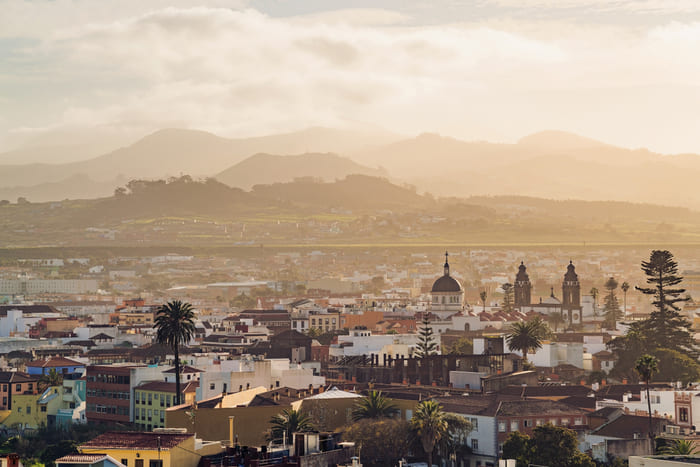
Interesting Facts about La Laguna
- Influential Urban Planning: La Laguna was one of the first cities not only in Spain but in the world to be planned according to an orthogonal design, a feature that would later influence the design of many cities in the New World, including Havana and Lima. This early planning is visible today in its orderly layout and the symmetry of its streets.
- University of La Laguna: Founded in 1792, the University of La Laguna was the first university in the Canary Islands and remains an important educational and cultural center. Its establishment marked a milestone in the educational and scientific development of the islands and continues to attract students from around the world.
- La Noche en Blanco: La Laguna is famous for its «Noche en Blanco,» a cultural event that takes place annually where museums, shops, and restaurants stay open all night. The event includes concerts, exhibitions, and many cultural activities, reflecting the vibrant community life of the city.
Puerto de la Cruz
Puerto de la Cruz, located on the north coast of Tenerife, is one of the oldest and most charming resorts in the Canary Islands. With a rich history dating back to the 16th century, this coastal town blends a quaint old-world ambiance with modern tourist attractions. Over the years, Puerto de la Cruz has managed to maintain its Canarian identity while evolving into a top tourist destination, offering a vibrant mix of culture, nature, and recreation.
A little history
Originally known as Puerto de la Orotava, Puerto de la Cruz was the most important port of Tenerife before the eruption of the Trevejo Volcano that benefited the port of Garachico. Throughout the centuries, it was a meeting point between Europe and the New World, contributing to its development as a commercial and cultural center. In the 19th century, it began to gain fame as a health destination for European tourists, especially the British, laying the foundation for its future tourism vocation.
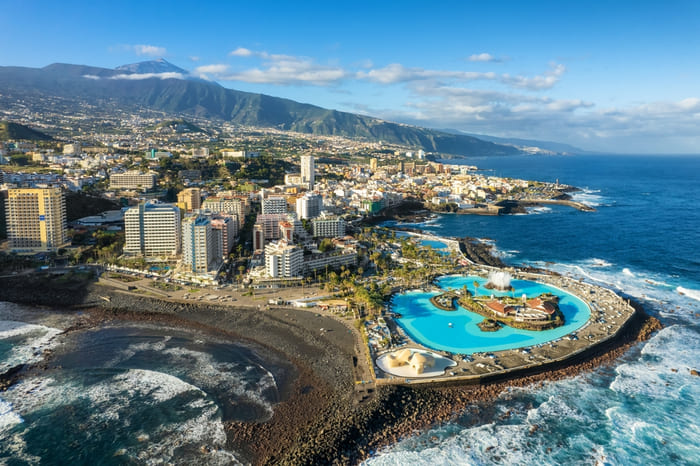
Landmarks
- Lago Martiánez: Designed by Canarian artist César Manrique in the 1970s, this complex of saltwater pools is one of the most famous attractions in Puerto de la Cruz. Lago Martiánez is not only a spectacular place for swimming and sunbathing but also an outstanding example of artistic integration with the natural environment.
- Botanical Garden: Founded at the end of the 18th century to acclimatize species brought from America, the Botanical Garden of Puerto de la Cruz is an oasis of tranquility and a showcase of biodiversity. This garden hosts an impressive collection of tropical and subtropical plants and is an ideal spot for nature and botany enthusiasts.
- Playa Jardín: Also created by César Manrique, this beach is famous for its volcanic black sand and lush gardens. In addition to being a beautiful place to relax and enjoy the sea, Playa Jardín has excellent facilities and services, making it ideal for families.
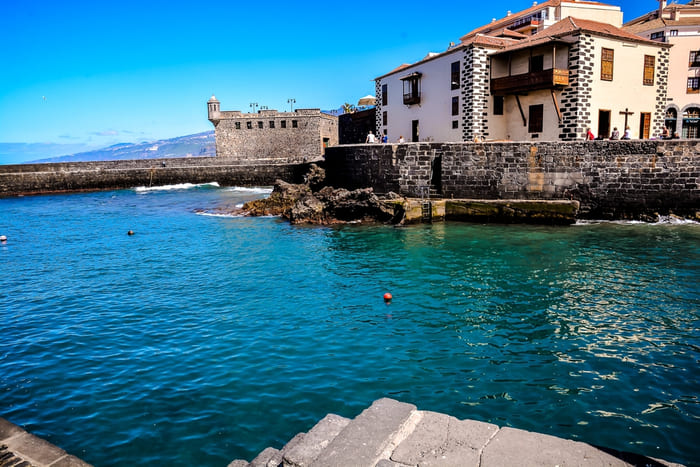
Interesting Facts about Puerto de la Cruz
- Fiestas del Carmen: Every July, Puerto de la Cruz celebrates the Fiestas del Carmen, one of the city’s most important and picturesque events. The festivities include the traditional maritime procession, where the Virgin of Carmen, patron saint of sailors, is carried by the sea accompanied by a fleet of decorated boats.
- The Old Casino: The old Casino of Puerto de la Cruz, which now functions as a center for events and exhibitions, is an iconic building with impressive architecture that reflects the splendor of bygone times. Located on the San Telmo promenade, it is an important cultural meeting point in the city.
- The Fishing Pier: Although today it is more touristic, the fishing pier of Puerto de la Cruz remains a place where one can see fishermen in action and buy fresh fish. This activity keeps the city’s maritime heritage alive and provides direct contact with one of the island’s most deep-rooted traditions.
La Orotava
Garachico is one of the historical gems of Tenerife, located on the northwest coast of the island. With a rich history marked by volcanic eruptions, tsunamis, and fires, Garachico offers a testament to resilience and cultural preservation. This charming coastal town, once the main port of Tenerife, now invites visitors to explore its architectural heritage, traditions, and unique natural surroundings.
A little history
The history of La Orotava is deeply intertwined with the conquest and colonization of the Canary Islands. Founded in the 15th century after the Spanish conquest of Tenerife, La Orotava quickly became an important agricultural and social center due to its fertile soil and favorable climate. The town was home to many aristocratic families, whose manor houses and palaces still adorn the cobbled streets, offering a window into the life of the elite in colonial times.
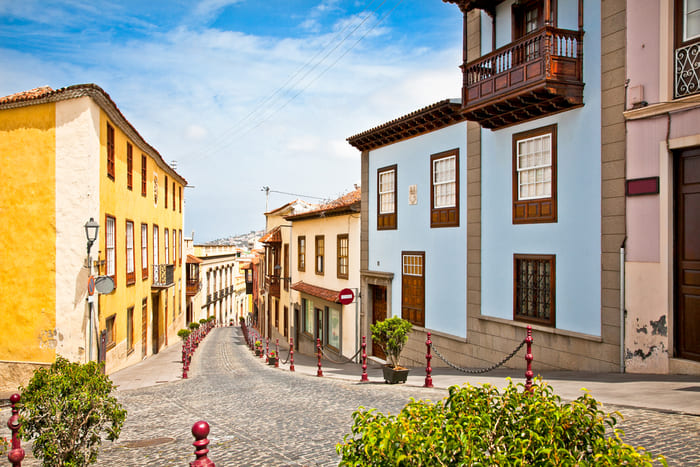
Landmarks
- Casas de los Balcones: One of the most emblematic sites in La Orotava is the Casas de los Balcones, a set of historic buildings famous for their intricate carved wooden balconies. Dating from the 17th century, these houses are a magnificent example of traditional Canarian architecture and today house a museum that displays local crafts and typical products.
- Jardines del Marquesado de la Quinta Roja: This botanical garden is another of La Orotava’s treasures. With a wide variety of exotic and native plants, these gardens are not only a center for the conservation of Canarian flora but also a place of great beauty and tranquility that reflects the nobility’s passion for botany and landscape design.
- Iglesia de la Concepción: The main church of La Orotava is an impressive example of Baroque architecture and is known for its beautiful altarpiece and rich interior decoration. The church plays a central role in the cultural and spiritual life of the town, being the venue for numerous festivities and religious celebrations.
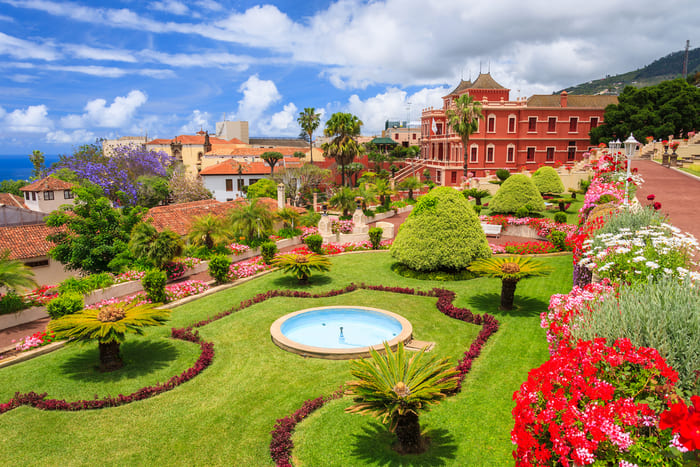
Interesting Facts about La Orotava
- Flower Carpets: La Orotava is famous for its Corpus Christi celebration, where the streets are adorned with spectacular carpets of flowers and volcanic sand. This artistic event attracts visitors from all over the world and is an impressive display of ephemeral art and the devotion of the city’s inhabitants.
- Views of Teide: From various points in La Orotava, one can obtain breathtaking views of Teide, the highest peak in Spain. The town’s relationship with the volcano is profound, influencing its climate, agriculture, and tourism.
- Gastronomic Heritage: The cuisine of La Orotava reflects its agricultural history. Dishes like «potaje de berros,» made with local ingredients, are a must for anyone visiting the town, offering flavors that are as rich as its history.
